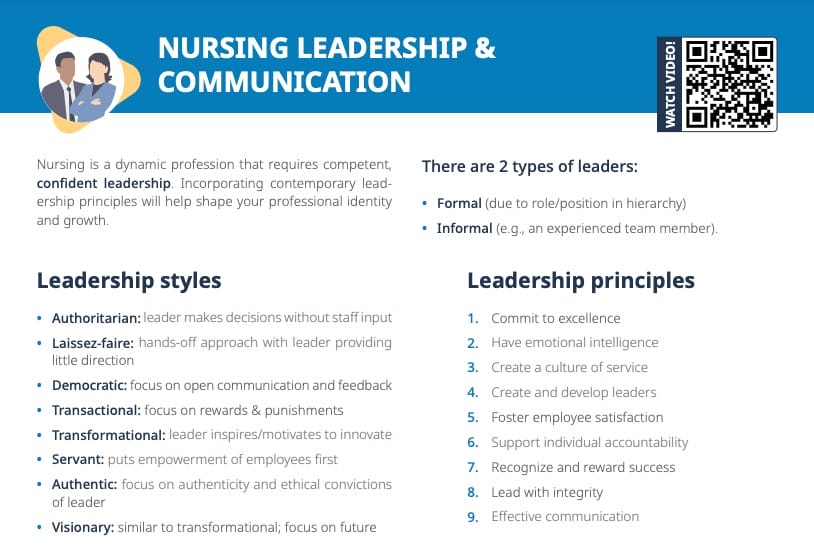What are communication types?
What is communication?
Communication is a process by which meaning is assigned to the needs, feelings, perceptions, and interpretation of what is brought to our awareness.
Forms of communication
Communication can be verbal (spoken or written word) or nonverbal (includes appearance, body language, gestures); and symbolic (e.g., art, music). The term metacommunication refers to situations when the verbal and nonverbal language may not match, and conclusions are drawn from both verbal and nonverbal expressions (e.g., a patient stating a body part does not hurt, but flinches intensely when touched).
Communication in nursing
Communication in nursing practice is a critical skill for all nurses with clients, families, and their health care team members.
Effective communication:
- Helps prevent errors
- Creates better patient outcomes
- Makes for better patient experience
There are lots of different types of communication you may encounter in your nursing team, the most notable being aggressive, passive, and assertive. Other types of communication refer to specific communication skills and techniques that are needed in nursing practice for specific situations, like therapeutic communication.
Professional communication
Regardless of the situation and other communication styles employed, there are basic requirements and tips regarding communication style that are part of a professional presentation and image to your patients as a healthcare professional. Examples include:
- Professional appearance
- Using names when addressing people
- Being honest
- Controlling one’s behavior (e.g., never yelling aggressively)
- Being courteous
What is assertive communication?
Assertive communication means expressing your point of view in a way that is clear and direct while still respecting others. It means taking responsibility for your own behaviors and emotions.
Benefits of assertive communication
- Minimizes conflict
- Helps control anger by providing clear understanding
- Requested needs are understood and met better
Assertive communication techniques
- State your point of view or request clearly
- Mind your tone and volume of voice
- Make sure your body language matches
- Don’t exaggerate (e.g., “never,” “always”)
- Use “I statements”
Assertion vs aggression
With aggression, you are forcing your needs or opinions on others, sometimes even with shouting or bullying behaviors. Aggressive communication can damage self esteem as well as relationships. In assertion, you’re using clear but respectful expressions of your needs while also considering others’ needs and often reaching compromise.
Assertive vs passive communication
Passive communication means putting your needs last and not speaking up, maybe even letting yourself be ignored or actively undermining your opinions. An example would be saying “Well only if you really want to do that, if not I’ll get it done…”
What is group communication?
To achieve positive outcomes for patients and families, a collective effort of individuals participating in teams, groups, and meetings in the healthcare facility is indispensable.
Stages of group development
There are 4 stages of group development:
- Forming phase: positive atmosphere, potential anxiety, leader role very important, figuring out responsibilities
- Storming phase: pushing against boundaries, conflicts arise
- Norming phase: differences get resolved, authority respected, potential socializing
- Performing phase: hard work without friction, structures and processes work well
Strategies for effective group communication
- TeamSTEPS:
- Evidence-based training program
- Goal: eliminate medical errors related to ineffective communication
- 5 key principles: team structure, communication, leadership, situation monitoring, mutual support
- SBAR:
- Stands for: situation, background, assessment, recommendations
- Tool for hand-off communication
- HUDDLES:
- Stands for: healthcare, utilizing, deliberate, discussion, linking, events
- Shared mini-model within the team; promotes employee satisfaction
Tips for communication with interdisciplinary teams
- Be proactive: Some conflicts between teams (e.g., floor nurses and lab) arise from negligence in communication and making assumptions.
- Ask yourself questions about other teams’ situation, goals, and needs:
- What is the other team actually doing, and how are they trying to do their job?
- What is the impact the work of the other team has?
- What are their greatest challenges – and how can you help?
- Educate yourself: Understanding the entire process of the patient experience can heavily impact our ability to effectively work together.
- Chaplin
- Pharmacist
- Therapists
- Charge nurse
- Healthcare providers
- Case managers
- Nutritionists
- Respiratory therapist
- Etc.
What is therapeutic communication?
Therapeutic communication is a communication style or skill that is applied not between nursing colleagues or the healthcare team, but with patients who you are in a therapeutic relationship with.
Therapeutic communication is defined as the face-to-face process of interacting that focuses on and prioritizes advancing the physical and emotional well–being of a patient.
Challenges and barriers in therapeutic communication
- Developmental age of the patient (e.g., babies only can cry) or level of consciousness
- Emotional state, medication effects (sedation) or high levels of stress
- Nature of the relationship (e.g., seeing nurse as authority can be detrimental to opening up)
- Cultural differences
Examples of non-therapeutic communication
- Shutting someone down
- Making someone hurry
- Giving advice
- Approving or disapproving (scolding)
- Persistent questioning
- Assuming and interpreting
Therapeutic communication techniques
- Active listening: actually comprehending rather than just hearing
- Silence: enduring silence to open up space for the client to keep talking
- (Re-) focusing: gently redirecting the conversation to the topic
- Open-ended questions: give space for more constructive answers than just yes or no
- Clarification: repeating back
- Exploring: go deeper on topic that was mentioned
- Summarizing: highlighting key take-aways
Nursing tips to remember about therapeutic communication
- “A therapeutic relationship is not a social one!” Rather than going both ways like a friendship would, in a therapeutic relationship, the healthcare team member keeps the spotlight on the patient at all times.
- Silence can be helpful and needs practice to endure.
- If a situation with a patient is making you uncomfortable and you feel like you cannot engage in professional therapeutic communication, it is important to step back and allow the person the right to speak to someone who can.

